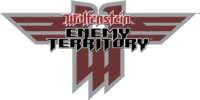Wolfenstein: Enemy Territory: Difference between revisions
No edit summary |
No edit summary |
||
| Line 18: | Line 18: | ||
|genre = [[First-person shooter]] | |genre = [[First-person shooter]] | ||
|mode = [[Multiplayer video game|Multiplayer]] | |mode = [[Multiplayer video game|Multiplayer]] | ||
|platform = [https://en.wikipedia.org/wiki/Linux Linux], [https://en.wikipedia.org/wiki/AROS_Research_Operating_System AROS], [https://en.wikipedia.org/wiki/Macintosh Mac] ([https://en.wikipedia.org/wiki/Universal_binary Universal]), [https://en.wikipedia.org/wiki/Microsoft_Windows Windows], [https://en.wikipedia.org/wiki/MorphOS MorphOS] | |platform = [https://en.wikipedia.org/wiki/Linux Linux], [https://en.wikipedia.org/wiki/AROS_Research_Operating_System AROS],<br /> | ||
[https://en.wikipedia.org/wiki/Macintosh Mac] ([https://en.wikipedia.org/wiki/Universal_binary Universal]), [https://en.wikipedia.org/wiki/Microsoft_Windows Windows], [https://en.wikipedia.org/wiki/MorphOS MorphOS] | |||
}} | }} | ||
'''Wolfenstein: Enemy Territory''' is a [https://en.wikipedia.org/wiki/Free_and_open-source_software free and open source] multiplayer [https://en.wikipedia.org/wiki/First-person_shooter first-person shooter] [https://en.wikipedia.org/wiki/Video_game video game] set during [https://en.wikipedia.org/wiki/World_War_II World War II]. It was originally planned to be released as a commercial [https://en.wikipedia.org/wiki/Expansion_pack expansion pack] to ''[https://en.wikipedia.org/wiki/Return_to_Castle_Wolfenstein Return to Castle Wolfenstein]'' and later as a standalone game. However, due to problems with the single-player aspect, the multiplayer portion was released on 29 May 2003 as a [https://en.wikipedia.org/wiki/Freeware freeware] standalone game. In January 2004, the [https://en.wikipedia.org/wiki/Source_code source code] for the game logic (not the game engine) was released to the benefit of its [https://en.wikipedia.org/wiki/Mod_(video_gaming) modding] community. | '''Wolfenstein: Enemy Territory''' is a [https://en.wikipedia.org/wiki/Free_and_open-source_software free and open source] multiplayer [https://en.wikipedia.org/wiki/First-person_shooter first-person shooter] [https://en.wikipedia.org/wiki/Video_game video game] set during [https://en.wikipedia.org/wiki/World_War_II World War II]. It was originally planned to be released as a commercial [https://en.wikipedia.org/wiki/Expansion_pack expansion pack] to ''[https://en.wikipedia.org/wiki/Return_to_Castle_Wolfenstein Return to Castle Wolfenstein]'' and later as a standalone game. However, due to problems with the single-player aspect, the multiplayer portion was released on 29 May 2003 as a [https://en.wikipedia.org/wiki/Freeware freeware] standalone game. In January 2004, the [https://en.wikipedia.org/wiki/Source_code source code] for the game logic (not the game engine) was released to the benefit of its [https://en.wikipedia.org/wiki/Mod_(video_gaming) modding] community. | ||
The game uses a modified ''Return to Castle Wolfenstein'' engine, itself being a heavily modified [https://en.wikipedia.org/wiki/Id_Tech_3 id Tech 3] engine, which has been [https://en.wikipedia.org/wiki/Open-source_software open source] since 2005. As of the first day of the 2010 [https://en.wikipedia.org/wiki/QuakeCon QuakeCon], 12 August the entire source code was released under the [https://en.wikipedia.org/wiki/GNU_General_Public_License GNU General Public License] v3. Multiple [https://en.wikipedia.org/wiki/Source_port source port]s have been started. While the work by the OpenWolf and ET:Xreal teams concentrate on innovating the renderer, the most active community project, ET: Legacy, focuses on fixing issues by backporting improvements from [https://en.wikipedia.org/wiki/Id_Tech_3#ioquake3 ioquake3] while staying [https://en.wikipedia.org/wiki/Binary_code_compatibility binary compatible] with the original game client, server and its mods. | The game uses a modified ''Return to Castle Wolfenstein'' engine, itself being a heavily modified [https://en.wikipedia.org/wiki/Id_Tech_3 id Tech 3] engine, which has been [https://en.wikipedia.org/wiki/Open-source_software open source] since 2005. As of the first day of the 2010 [https://en.wikipedia.org/wiki/QuakeCon QuakeCon], 12 August the entire source code was released under the [https://en.wikipedia.org/wiki/GNU_General_Public_License GNU General Public License] v3. Multiple [https://en.wikipedia.org/wiki/Source_port source port]s have been started. While the work by the OpenWolf and ET:Xreal teams concentrate on innovating the renderer, the most active community project, ET: Legacy, focuses on fixing issues by backporting improvements from [https://en.wikipedia.org/wiki/Id_Tech_3#ioquake3 ioquake3] while staying [https://en.wikipedia.org/wiki/Binary_code_compatibility binary compatible] with the original game client, server and its mods. | ||
Revision as of 07:21, 17 March 2017
Wolfenstein: Enemy Territory

Developer(s)
Publisher(s)
Distributor(s)
Director(s)
Producer(s)
Designer(s)
Programmer(s)
Artist(s)
Writer(s)
Composer(s)
Series
Engine
Release
Genre(s)
Mode(s)
Platform(s)
Richard Jolly
Jonathan Moses
Kevin Cloud (executive)
Paul Wedgwood
Matt Wilson (level)
Arnout van Meer
Richard Jolly
Edward Stern
29 May 2003
Linux, AROS,
Mac (Universal), Windows, MorphOS
Wolfenstein: Enemy Territory is a free and open source multiplayer first-person shooter video game set during World War II. It was originally planned to be released as a commercial expansion pack to Return to Castle Wolfenstein and later as a standalone game. However, due to problems with the single-player aspect, the multiplayer portion was released on 29 May 2003 as a freeware standalone game. In January 2004, the source code for the game logic (not the game engine) was released to the benefit of its modding community.
The game uses a modified Return to Castle Wolfenstein engine, itself being a heavily modified id Tech 3 engine, which has been open source since 2005. As of the first day of the 2010 QuakeCon, 12 August the entire source code was released under the GNU General Public License v3. Multiple source ports have been started. While the work by the OpenWolf and ET:Xreal teams concentrate on innovating the renderer, the most active community project, ET: Legacy, focuses on fixing issues by backporting improvements from ioquake3 while staying binary compatible with the original game client, server and its mods.
